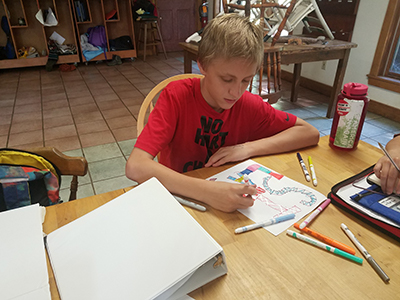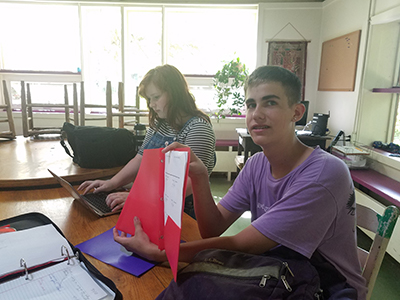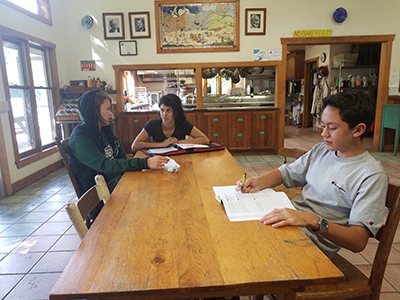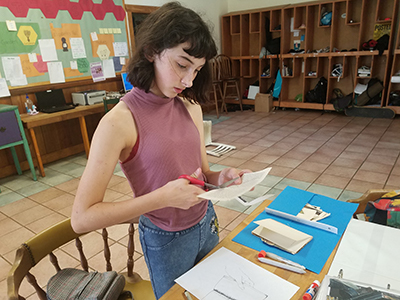Helping Students Take Ownership of their Learning

One of the biggest changes from elementary school to middle school is switching classes. Moving from math in one classroom to a different language arts class to a third history class, all with separate teachers, can be very disorienting. Students can begin to view school as just a sequence of different classes, each with its own set of assignments and expectations. As a result they sometimes fail to apply information or skills they learn in one class to other settings. Middle schoolers need guidance seeing the bigger picture when it comes to their education. For students to take ownership of their learning, they need help not just focusing on how to study for a single test, but how to advocate for all their educational needs.
Academic Advising Promotes Ownership of Learning
To accomplish this goal, some schools are providing special tutors and study periods that focus solely on building better study habits. These tutors help students determine strategies that will help them in all of their classes. The students take ownership of their learning by talking about school as a connected experience rather than a series of different subjects.
Arthur Morgan School uses this strategy with great success. They call it Academic Advising. Their middle schoolers are separated into small groups of four to five students and meet every day with an advisor. The members of each group are diverse in their grade level and academic ability. This allows for students to help each other just as much as the advisor helps them. When the group meets, students use the time to think about schoolwork on the whole as well as address issues that might be arising in a specific subject. In this way, a student might see that a problem they are having in language arts class could be improved by a strategy they employ in Spanish.
 Real Relationships Yield Real Results
Real Relationships Yield Real Results
Students stay with the same advisor all year, even all three years if possible, allowing them to build strong relationships. During these meetings, they might not just talk about schoolwork. They also discuss what their home life is like, how previous academic experiences shaped their confidence, and their aspirations and dreams. In this way, the advisor gets to know each student really well and helps them achieve what they want, instead of what some far off school administrator is setting up for them. Theo, a ninth grader at AMS, set up many goals for himself over his three years at AMS. They include improving his spelling, learning Spanish, making impact on the school community, and constructing a cornicorn (a unicorn made out of corn cobs).
Advisors understand each of their student’s strengths and challenges, but more importantly, so do the students. The students discuss what strategies work for them and how to implement them in different settings. They set up goals for each day, week and semester and then evaluate their progress towards those goals. By their third year at AMS, ninth graders are thinking about what goals they want to set for themselves when they transfer to high school. They are demonstrating an ownership of learning that will stay with them throughout college and beyond.
Making Bigger Connections
 Academic advisors also helps students prepare their portfolios, set up open house presentations, and get ready for their student-led conferences. All three of these activities provide students with the opportunity to demonstrate what they are learning and articulate what inspires them. Students select what work they want to show off in their portfolio. They create their presentations and choose what topics they want to cover in their conference. The academic advisor helps each student find their voice and encourages them to focus on their passions and interests.
Academic advisors also helps students prepare their portfolios, set up open house presentations, and get ready for their student-led conferences. All three of these activities provide students with the opportunity to demonstrate what they are learning and articulate what inspires them. Students select what work they want to show off in their portfolio. They create their presentations and choose what topics they want to cover in their conference. The academic advisor helps each student find their voice and encourages them to focus on their passions and interests.
They also help students reflect on their academic achievement at these moments, celebrating their successes and learning from their mistakes. Lillian, an AMS graduate, says of her portfolio, “In seventh grade, my portfolio was awful. I only wanted to put in my final drafts. I wanted it to be perfect. But by ninth grade, I include a lot of unfinished projects to show how my progress has improved.”
While the academic advisor is doing all this, they are helping the student make connections to the bigger world. Sometimes a topic in class can feel isolated to the experiment or project they are completing. It is not uncommon for a student to ask, “When am I ever going to need this?” The academic advisor helps students see how their classes are relevant and how they might serve the student in their future goals.
Challenging Moments Make for Learning Opportunities
 The work of an academic advisor is not always fun. When students are feeling unengaged and refuse to do their work, it is often the advisor who sits down and talks with them. In these moments, the advisor is not there to come down on them or add to their shame. Middle schoolers are naturally curious and want to feel useful and competent, so the advisor understands that if a student is underperforming there is usually something bigger happening.
The work of an academic advisor is not always fun. When students are feeling unengaged and refuse to do their work, it is often the advisor who sits down and talks with them. In these moments, the advisor is not there to come down on them or add to their shame. Middle schoolers are naturally curious and want to feel useful and competent, so the advisor understands that if a student is underperforming there is usually something bigger happening.
The advisor will help the student find the cause of their disengagement and then address it. Some students need to learn how to advocate for themselves and ask for a different assignment that inspires them. Other times they need to process an emotional hurdle that is consuming all of their energy, and find ways to prevent their feelings from interfering with their work. Sometimes, they just need to know that another person believes they can do it. By learning how to solve their problems, AMS’s middle schoolers aren’t just figuring out how to be better students, but how to take ownership over a lifetime of learning!
-by Nicholas Maldonado
